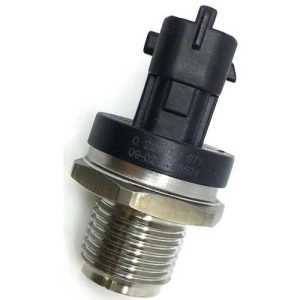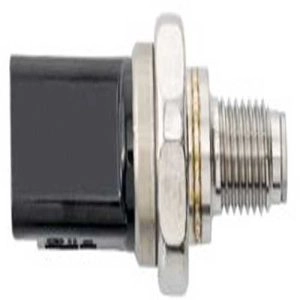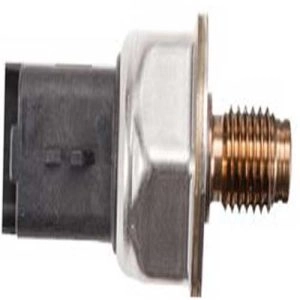The gasoline sensor FRP is one of the important sensors in the car. Its function lies in accurately measuring the pressure within the injector rail in a very short period of time. After collecting the correct information, it sends it to the car's computer to regulate the gasoline pressure through the regulator. The computer analyzes this information and makes the necessary adjustments to control the timing and quantity of fuel injection. Because supplying the engine with more fuel than it needs in the combustion chamber leads to greater fuel consumption, this results in an increase in the gases emitted from the exhaust, and reduces the natural lifespan of many internal engine components.
The fuel sensor is usually located near the middle of the fuel injection rail, and if it gets damaged or malfunctions, the engine control system will not be able to perform its functions properly. This can lead to a few problems while driving, especially engine stalling while it's running, or difficulty starting it.
In this article, we aim to provide you, our dear reader, with some information you need to know about the gasoline sensor, particularly its importance, how it works, and signs that indicate its damage.
The Importance of the FRP Gasoline Sensor

The information and data sent by the fuel sensor to the car's computer are important and sensitive. It sends a signal to control the amount of fuel that should be supplied to the engine via the injectors, and when this should happen. These operations depend on driving and car conditions, the speed levels reached by the driver, and also when the car is in idle mode when it is stationary.
This means, if the fuel pressure sensor is damaged or malfunctioning, and does not provide accurate data and information to the control unit, the amount of fuel that should be supplied and injected will be incorrect. In other words, the engine will be supplied with more or less fuel than required in the combustion chamber. This could lead to two things: in case of excess, fuel consumption will significantly increase and the emissions from the car will rise. Conversely, in case of shortage, the car's performance will decrease, engine's power and torque will drop, and acceleration will slow down.
Also read: Cleaning the throttle without the need for programming.
Signs of Fuel Sensor Damage

The car's computer can determine whether the fuel sensor is damaged or not, through the electronic signal it receives. If it receives intermittent, absent, irregular signals, or signals that fall outside the range set by the manufacturer, then the computer indicates a fault in the sensor.
Some symptoms may appear on the car's performance and engine that could be a warning sign of a malfunctioning fuel pressure sensor. These symptoms are often not clear, but at least you should notice one of the following signs that may indicate the sensor is damaged.
Difficulty starting the engine:If you've tried to start the engine and it didn't work, or it took several attempts to get it running, it might be due to a faulty fuel sensor. This is because the car's computer is not sending the proper amount of fuel to the engine, making it difficult to start the engine and requiring time and effort.
You can confirm if the sensor is the cause of the problem by unplugging the sensor from its place, then trying to start the engine. If the sensor is damaged, the car should operate without any issues. However, if the problem persists and you still find difficulty, then the problem is not with the sensor, and you should look for the real cause.
Check Engine Light Appears:If the car's computer detects that the signals sent by the sensor are incorrect, it will illuminate the engine check light on the dashboard for you to see, and the computer stores a specific error code corresponding to the issue with the sensor. These codes will appear when the car's computer is examined using a diagnostic device.
Engine performance decline:If you notice that the car is responding incorrectly when you press the gas pedal, not as you were used to before or as usual, then there might be some errors in the gas sensor. This is due to the same reason we mentioned earlier. The sensor sends incorrect signals to the computer, which results in the computer's inability to meet the engine's fuel requirements. You might also notice some rough idling and vibrations.

Black smoke and increasing emissions:If your car is consuming a excessive amount of fuel, you will notice an increase in the amount of emitted gases. This is because damage to the fuel sensor leads to an increase in the amount of fuel injected into the combustion chamber, in quantities that do not match the amount of air calculated by the car's computer. Here, not all the fuel will burn due to the lack of sufficient oxygen with the air, and hence it will appear as black smoke and exhaust emissions. It's worth mentioning that there are several reasons for increased emissions, but damage to the fuel sensor is the most crucial.
The engine suddenly stops or cuts off in its operation.Sometimes the car engine stops when the condition becomesGasoline SensorThe worst-case scenario could be the car suddenly stopping while driving, noting an interruption in the engine's operation, or a wrong change in its operation during acceleration or deceleration. All of these make driving very difficult and unsafe for the car or the driver, and may lead to road accidents. Therefore, the car should be checked by a specialized technician to identify the problem, which could be due to another reason other than damage to the fuel sensor. In this case, it is not necessarily required to replace the old sensor with a new one.

Comments